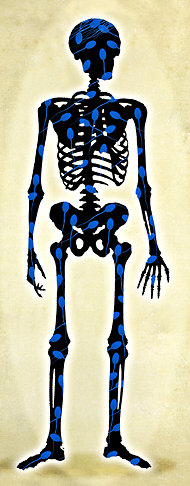In Theory
Examining the Mystery of Skeleton, Sugar and Sex
By AMANDA SCHAFFER
Published: August 22, 2011
THE HYPOTHESIS Bones help regulate fertility in men.
THE INVESTIGATOR Dr. Gerard Karsenty, Columbia University.
For years, scientists thought they understood the skeleton. It serves as structural support for the body. It stores calcium and phosphate. It contributes to blood cell development. And it serves, indispensably, as the creepy mascot of Halloween.
But as it turns out, there may be still more to bone.
A few years ago, researchers at Columbia University Medical Center discovered, to everyone’s surprise, that the skeleton seems to help regulate blood sugar. Now the team, led by Dr. Gerard Karsenty, geneticist and endocrinologist at Columbia University, has found that bone may play an unexpected role in reproduction. If the work pans out, it may help to explain some cases of low fertility in men.
“It’s definitely an attention-grabber,” Dr. William Crowley of Harvard Medical School, who was not involved in the research, said of the new finding regarding fertility. “I think it will turn out to be a seminal observation.” (No pun intended, presumably.)
It is well known that the hormones estrogen and testosterone, produced in the ovaries and testes, help to regulate bone growth. When women reach menopause, estrogen levels decrease along with bone mass, putting them at increased risk for osteoporosis. As men age, their testosterone and estrogen levels decline, as well. Men lose bone, but much more slowly than women do.
“We thought that if the sex organs talk to the skeleton, then the skeleton should talk back to the sex organs,” Dr. Karsenty said.
Apparently it does.
Early this year, Dr. Karsenty’s team published a study demonstrating that in mice a protein called osteocalcin, which is produced by bone-forming cells called osteoblasts, binds to a specific receptor on cells of the testes. Male mice that were unable to make osteocalcin (as a result of genetic manipulation) produced less testosterone and were less fertile. When they mated, they had fewer and smaller offspring.
Fertility in female mice, on the other hand, was not affected by osteocalcin. Cells in their ovaries lacked the receptors to which the bone hormone binds.
“We were surprised by that,” said Dr. Karsenty. “We thought we’d find a hormone that regulated fertility in both sexes.” Another compound, as yet unknown, may play the analogous role in females, he added.
Human testicular cells also have receptors for the hormone osteocalcin, Dr. Karsenty has found.
“I don’t know of any hormone that functions in mice but not to some extent in humans,” said Thomas Clemens, a researcher at Johns Hopkins University.
Still, the magnitude of the effect may not be the same as in mice.
The main hormone that stimulates testosterone production, in mice and men, is luteinizing hormone, a protein made in the brain. Luteinizing hormone is “the on-off switch” for testosterone, said Dr. Crowley. Osteocalcin, on the other hand, looks more like a “dimmer switch” that modulates the process.
The question: Is it a critical mechanism or a backup system? Does osteocalcin play a widespread role in problems like low sperm count and low testosterone, or is it more peripheral?
Scientists now plan to study men with these problems and to measure their osteocalcin levels, said Dr. Crowley. Some of them may have a defect in osteocalcin or its receptor that underlies their conditions.
But, he said, “I suspect this will turn out to be one chapter in an interesting and more complicated mystery.”
Dr. Karsenty has long argued that bone plays a central role in regulating body physiology. “The body is not an assembly of silos that don’t speak to each other, but is full of surprising examples of crosstalk,” he said.
In 2007, he showed that bone helps to regulate blood sugar, a result that startled hormone specialists. Working with mice, he reported that osteocalcin boosts insulin production in the pancreas and also increases insulin sensitivity (making the body more responsive to the hormone). Insulin, in turn, acts to lower blood sugar.
That work could prove relevant to diabetes, in which the body either does not produce enough insulin or stops heeding its directives. As a result, blood glucose levels become too high.
Now, Dr. Karsenty hopes to unravel the complicated links binding the skeleton, sugar and sex. Bone mass tends to decline with age, he notes, as do blood sugar control and fertility.
“One idea is that bone might not just be a victim of aging,” he said. “It might also be a contributor.”


